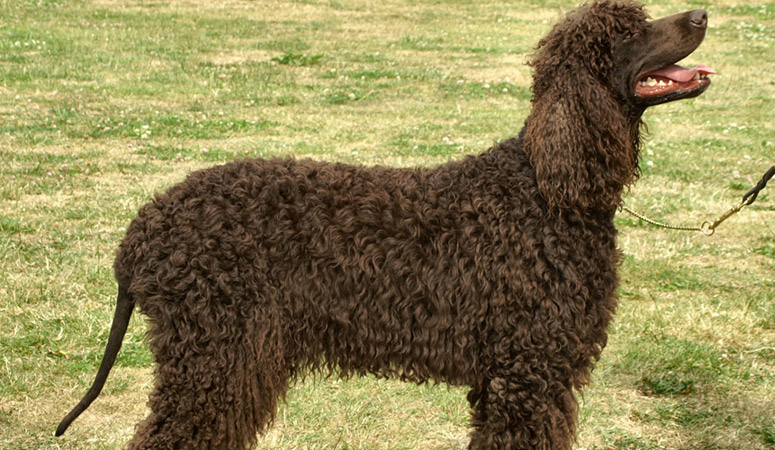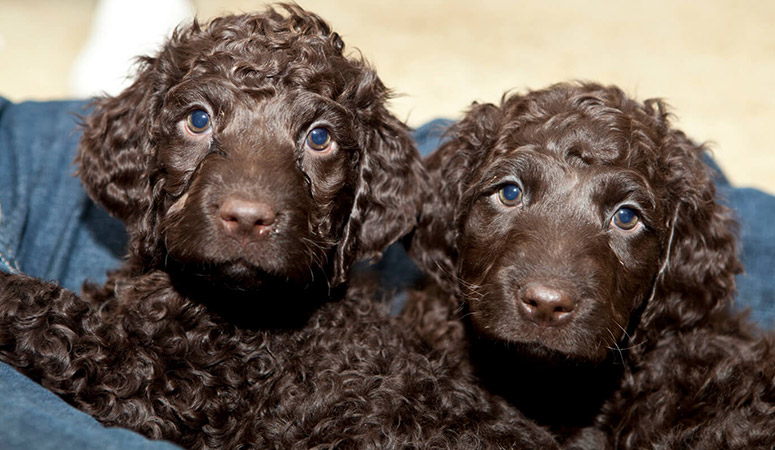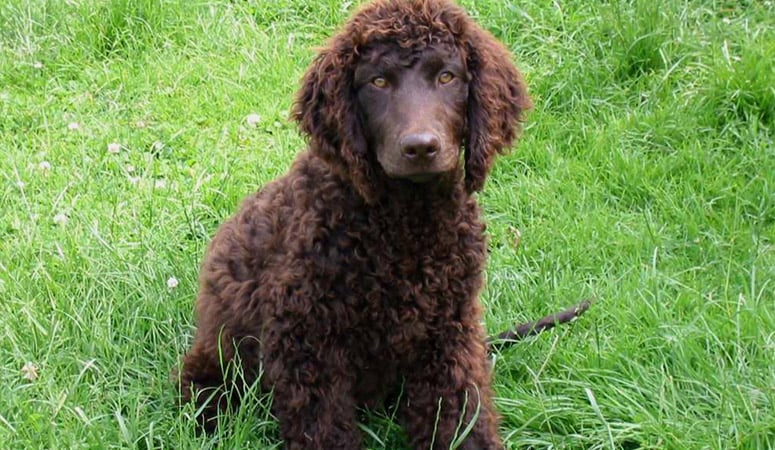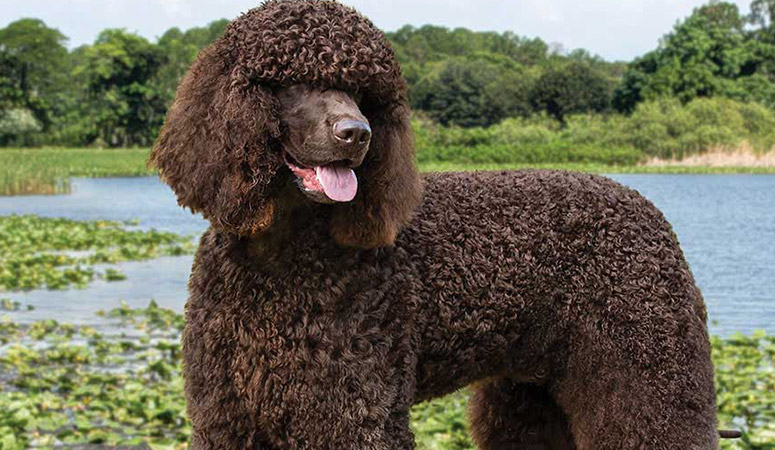Irish Water Spaniel

The Irish Water Spaniel is the largest and one of the oldest of spaniels, their expression is always alert, intelligent, and quizzical. Among the champion swimmers of dogdom, the alert and inquisitive IWS is hardworking and brave in the field, and playfully affectionate at home.
| Other Names | Whiptail, Shannon Spaniel, Rat Tail Spaniel |
| Color | Liver |
| Height | Males: 22-24 inches. Females: 21-23 inches. |
| Weight | Males: 55-68 pounds. Females: 45-58 pounds. |
| Life Span | 12-13 years |
| Personality | Playful, Hardworking, Brave |
| Exercise | Needs Lots of Activity |
| Origin |
| Popularity | #170 |
| Groom Needs | Weekly |
| Kids Friendly | Yes with supervision |
| Dog Friendly | Yes with supervision |
| Watch Dog | |
| Family Dog | Yes |
| Litter Size | 4-10 |
Irish Water Spaniel Pictures
Irish Water Spaniel Video
Introduction
Like most sporting dogs, the Irish Water Spaniel is an active and energetic dog bred for game hunting. Their intelligence and endurance have distinguished them amongst most other spaniels. On a fair day, an Irish Water Spaniel would perform an ordinary task in an extraordinary way. The dense, curly coat is waterproof and rarely sheds, if at all. It presents in a liver/puce color (with flecks of purple occasionally). A tapering tail, popularly known as “rat tail” is a hallmark of the Irish Water Spaniel.
Irish Water Spaniels are the largest amongst spaniels and tread the line between large-sized and medium-sized dogs. A standard male stands 22-25 inches at the shoulder and weighs 55-70 pounds, while a similar female normally measures around 20-23 inches from shoulder to paw and weighs about 45-60 pounds. The Irish Water Spaniel is classified as a member of the Sporting Group by the AKC and has a lifespan of 11-13 years.
Living with Irish Water Spaniel
Irish Water Spaniels shed little to no hair, but they must be brushed two or three times a week to keep the coat from tangling or matting, as well as to keep it clean and healthy. And the Irish Water Spaniel just needs a bath only every few months because his coat is protective, water-resistant oils.
The breed can be prone to ear infections due to the pendant earflap. The owner needs to check and clean the dog’s ears for redness, dirt, odor that may indicate infections. Brush your Irish Water Spaniel’s teeth at least two or three times a week to remove tartar buildup and the bacteria that lurk inside it. Daily brushing is better to keep fresh breath and prevent gum disease. Trim the nails as needed, usually every week or two.
As a typical sporting dog, the Irish Water Spaniel is an active, high-energy breed that needs a yard to romp in and isn’t suited to apartment life. They are eager to please which makes them relatively easy to train, but they need lots of daily exercises. The owner needs to give your dog at least an hour exercise a day, such as long walks or hikes, running alongside a bicycle, chasing a ball in the backyard, or playing with other dogs, which is helpful to keep physically and mentally healthy. Besides, if you have a pool or access to a lake, taking your dog to swim is a great option for him to get exercise.
Generally, it is recommended to feed the Irish Water Spaniel with one and a half to two and a half cups of high-quality dry dog food every day, divided into two meals. And there should be clean and fresh water at all times. More importantly, the food amount should depend on the dog’s weight, size, age, and activity level.
Some dogs are easy to get overweight, so you need to watch their calorie consumption and weight level all the time. Treats may be an important aid in training, but excessive intake can lead to obesity. Also, owners need to distinguish which human food is safe for dogs and which are not. If you have any problems with your dog’s weight or diet, just consult from your veterinarian.
The Irish Water Spaniels are prone to the following health conditions: hypothyroidism, ear infections, hair loss, hip and elbow dysplasia, eye conditions, including progressive retinal atrophy and cataracts, etc.
Major concerns: otitis externa, CHD
Minor concerns: distichiasis
Occasionally seen: hypothyroidism, seizures, elbow dysplasia, megaesophagus, nail-bed disease
Suggested tests:
Hip Evaluation
Thyroid Evaluation
Elbow Evaluation
Ophthalmologist Evaluation
Total Annual Cost: $3235
Cost is estimated for the first year and may vary depending on many factors, such as dog food, health care, leash, collar, licensing, possible fencing, crates, training and obedience classes, dog-walking, grooming, treats, toys, flea, tick, and heart-worm meds, microchips, etc.
The Irish Water Spaniel is playful, smart, and eager to please, though they work well with people, they can be independent, with a mind of their own sometimes. Train the dog with the kind but firm consistency, using positive reinforcements that include food rewards and praise. And it is necessary to keep training sessions fun and interesting to prevent the dog from being bored. The dog responds well to positive training methods, never use a harsh or heavy-handed approach, because it may bring undesirable results. Besides, they are great candidates for canine sports, such as agility, dock diving, rally, tracking, and flyball, and their sensitive nature makes them natural as therapy and assistance dogs.
History
The Irish Water Spaniel, as the name suggests, is of Irish descent. Some believe it’s got roots that go as far back as the 1500s. Before the mid-1800s, water spaniels recognized in Ireland were mainly the Tweed Spaniels, Northern Irish Spaniel, and Southern Irish Spaniel. Ancient Irish folklores suggest that the Irish Water Spaniel was probably a descendant of the Dobhar-chú breed. However, documented records about this breed point to Justin McCarthy as the pioneer who had developed the first purebred Irish Water Spaniel. He was believed to have used a breed of Water Spaniels of the South Country (Southern Irish Spaniel) in his breeding program in the 1930s. There are rumors that the breed must have descended from more than one breed and supporters of this notion are of the opinion that the likely ancestors of the Irish Water Spaniel include the Poodle, Barbet, Portuguese Water Dog, Irish Setter, and even the extinct English Water Spaniel. Whatever the case, modern Irish Water Spaniels are widely accepted as descendants of McCarthy’s Breed.
The Irish Water Spaniel was originally bred to retrieve birds from water and upland areas, though in America, they were also duck hunters. The dog show circuitry saw the debut of the Irish Water Spaniel in 1859, and ever since its popularity began to rise in England, Ireland, and beyond. In the 1870s, they were imported into the U.S, began to flourish immediately, and by 1875, it was already amongst the top 3 sporting breeds in the United States. The Irish Water Spaniel became one of the first breeds to be registered by the American Kennel Club (AKC) in 1878 before the club was founded in 1884.
Helpful Information
Breed Club: IRISH WATER SPANIEL CLUB OF AMERICA
Breed Club Link: https://www.iwsca.org/
Breed Club Rescue:
Breed Club Rescue Link: https://www.iwsca.org/rescueadoption.htm




